
Review
Deliver At All Costs review: madness on wheels
by Kim Muntinga
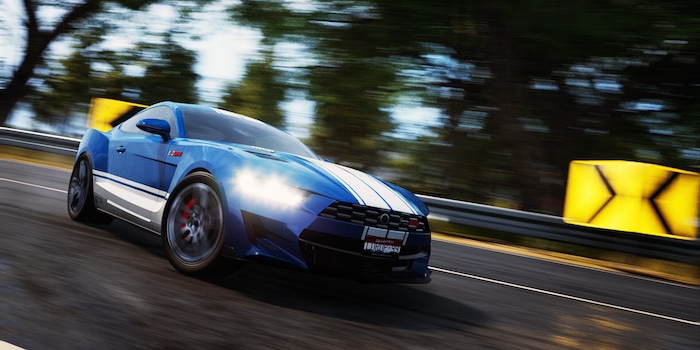
The spiritual successor to Burnout lets you redesign your own open world using ramps and obstacles, transforming the racing game into a construction kit for chaos and creativity.
I’m sitting in my speedy red race car on a wide coastal road, somewhere between the hills, the city and total freedom. The asphalt glistens in the sunlight, the air above shimmering in the heat. Traffic roars in the distance. In front of me, there’s a newly placed ramp that doesn’t actually belong there. I shift into third gear, hit the gas – and fly.
The car whooshes into the air and the sky tilts, the road turning into a grey strip far below me. For a brief moment, the world seems to stand still. Then, there’s an impact, an explosion and the game restarts. Wreckreation calls this fun. As for me, I call it an invitation to ditch the laws of reason at the garage entrance.
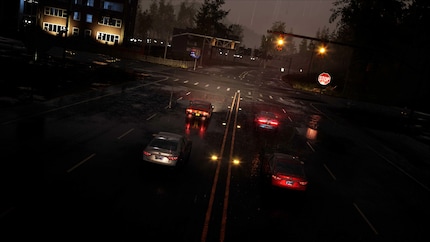
This game doesn’t want you to play by the rules. It wants you to reconstruct them. In the truest sense of the word. You can place ramps, loops or obstacles anywhere in the existing open world – no editor menus, no loading times. You come to a brief halt, position an object and the road changes on a dime. It feels like you’re pottering around in your very own playground. All while you’re going full throttle.
Wreckreation was created by Three Fields Entertainment, the developers behind Burnout. In fact, glimpses of Burnout – high speeds, brutal crashes, little realism – shine through at every curve. That being said, the team has tried to take the principle of the game a step further instead of simply tying it into a bygone era.
The game’s core principle is quickly explained: driving and design go hand in hand. You drive, build, experiment and sometimes fail big time. As appealing as this freedom is, it can sometimes leave you feeling at a loss. You see, Wreckreation hardly gives you any direction. There isn’t a typical career or a fixed sequence of races.
Instead, you slowly level up by completing challenges or beating record times. As you do this, you occasionally unlock new vehicles, get to customise their paintwork and components or create your own events. These range from simple sprints to crazy stunt courses. Activities like these appear throughout the open world, blending seamlessly into your free driving time. It’s more of an unassuming background structure than a demanding one.
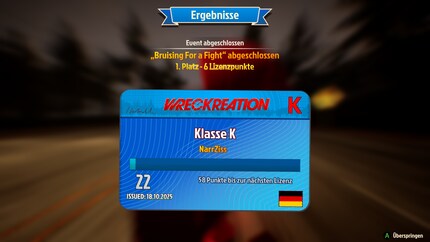
This all works much better in practice than it sounds. You soon realise the world is less of a backdrop than it is a stage. It reacts to every intervention, every new object. And since this response is so immediate, it creates a strangely meditative flow between driving, stopping, redesigning and driving on.
I like the fact that despite the game’s openness, it doesn’t feel haphazard. The world’s simple but clearly structured. Big enough for experimentation and empty enough to put your own ideas into practice.

When I first hit the road, I notice how familiar – and yet different – everything feels. The controls are instantaneous and almost old-fashioned in their simplicity. There’s no realistic sense of weight and no subtle physics. Just a driving experience that screams «arcade». Cars get busted up easily, drifts are more show than technique and every crash is a mini explosion of sparks and metal. It dawns on me that the game’s more about rhythm than precision.
At the same time, there are moments when the pace seems almost too fast. Racing over a hilltop at 250 km/h, your car feels more like a pinball than a vehicle. Even so, there’s something liberating about that – you don’t have to worry about traction control or racing lines. Wreckreation wants you to drive, not to drive «properly».
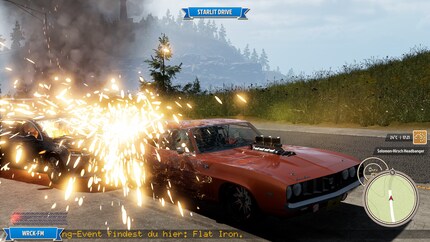
The game deliberately steers clear of assistance systems and racing lines. Mistakes aren’t just allowed – they’re encouraged. Every crash plays out in spectacular fashion, every flip of the car a little fireworks display. It reminds me of Burnout, without the aggressive, competitive vibe. In this game, an accident feels less like failure and more like an «oh well, let’s give it another go» situation.
Things get interesting when driving intermingles with building. You place a ramp, drive onto it, correct the angle and do the same thing again from scratch. There’s something satisfying about these constant changes – almost like a physical puzzle. You try, you fail and you make tweaks. If you’re expecting precise controls or defined rules, you won’t enjoy Wreckreation much. The game thrives on improvisation, not perfection.

Sometimes, the flow of the game grinds to a halt. The camera tends to lose track of large jumps, the physics randomly decide what’s «realistic» and landings feel more like luck than timing. But I can forgive that as long as the result looks spectacular. Wreckreation isn’t trying to be a clean-cut racer. It wants you to find yourself laughing while your car’s on fire.

Visually, Wreckreation seems like a game that knows exactly where its priorities lie – and realism doesn’t rank high on the list. The world is large, but simple. Roads run through green hills, past industrial areas, beaches and towns, none of which are shown in much detail. It looks good enough to be credible, but never as if it’s trying to impress.

The advantage of this is that the game runs stably, even at high speed and with earth-shattering explosions. Regardless of how many objects I place, the performance never dips. This is certainly nothing to be taken for granted in a game that inserts objects into the world in real time as you’re racing through it. The only thing that seems a little outdated is the loading times between game sections. It’s as if the game’s catching its breath before giving you full control again.
The game allows you to freely change the weather and time of day. At the touch of a button, bright sunshine turns into a rain-soaked afternoon. This may sound banal, but it adds variety to the game. The same tracks suddenly look different, the mood changing from relaxed to threatening. It’s these little visual nuances that make driving more exciting.

The user interface follows this same principle – it’s functional yet unconventional. At first, the little selection window on the left seems unusual, almost like a relic from another design era. But that’s precisely what makes it so appealing. While you’re driving, you can change radio stations, start events or adjust settings without interrupting the game. This is handy, albeit a tad fiddly sometimes.
Sound-wise, Wreckreation delivers exactly what you’d expect: roaring engines, screeching tyres and a muffled boom accompanying every crash. The radio stations cover different genres, from rock to country to pop, although I haven’t fully listened to all of them yet. Providing some pleasant background noise, the songs are rarely catchy, but never annoying. Overall, this results in a subdued but fitting soundscape. Two descriptors you could apply to the game itself.
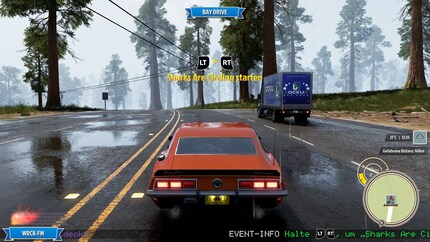
The thing Wreckreation does really successfully is create atmosphere through simplicity. It doesn’t need fancy graphics or an orchestral soundtrack to make an impact. When I’m driving over wet roads, water swirls up behind me. As an inconspicuous guitar riff plays on the radio, I feel a little moment of flow: quiet, unspectacular, but just right.

THQ Nordic provided me with the PC version of Wreckreation for testing purposes. The game has been available for PlayStation 5, Xbox Series X|S and PC since 28 October.
At the end of the game, I’m left feeling free. And slightly empty. Wreckreation isn’t the kind of game that captivates me. After releasing you into a world of asphalt and fantasy, it simply watches. This is refreshing, though sometimes sobering.
You build ramps, whoosh over them, fly, fall and laugh. And perhaps that’s exactly the point. Wreckreation doesn’t need big goals to be fun. Instead, it feeds off the little moments. Like that split second during which you land the perfect jump – or fail spectacularly.
Is that alone enough? Well, it depends on what drives you to play games. If you’re looking for structure, progression or competition, you’ll soon wonder what on earth you’re doing playing Wreckreation. However, if all you want to do is drive, build and cause a bit of chaos, you’ll discover one of the most honest sandbox racers released in a long time.
One feature I haven’t managed to try out yet is multiplayer mode. And this is exactly where Wreckreation’s full potential might just be able to unfold. If several players are building ramps, changing tracks or driving each other crazy at once, this quiet sandbox could instantly turn into a creative party. Maybe it’s moments like these, when the chaos is shared, that the game truly comes to life.
Pro
Contra
My interests are varied, I just like to enjoy life. Always on the lookout for news about darts, gaming, films and series.
Which films, shows, books, games or board games are genuinely great? Recommendations from our personal experience.
Show all